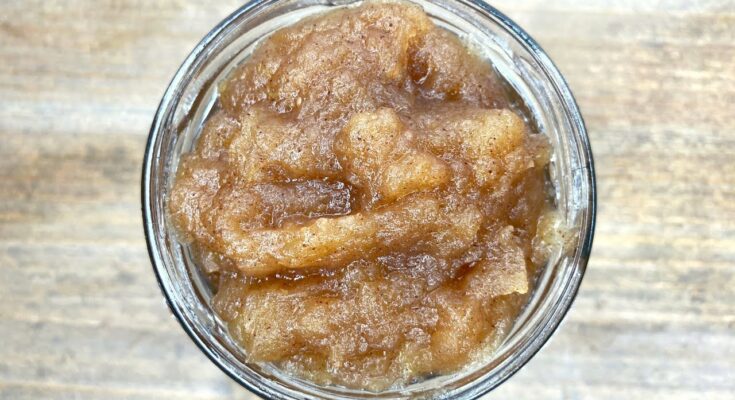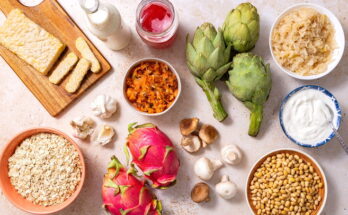Applesauce Recipe: Applesauce is a smooth, sweet, or slightly tart puree made from cooked apples. It can be enjoyed as a standalone treat, used as an ingredient in baking, or served as a versatile accompaniment to various dishes.
The Benefits of Making Applesauce at Home
Homemade applesauce is fresher, healthier, and tastier than store-bought options. You can control the ingredients, ensuring there are no preservatives, added sugars, or artificial flavors. Plus, it’s a great way to use up surplus apples!
Ideal Uses of Applesauce
From a topping for pancakes to a secret ingredient in cakes, applesauce has endless uses. It’s a wholesome snack for kids and adults alike and can even replace oil or butter in certain recipes for a healthier twist.
Ingredients and Tools Needed
Essential Ingredients
- 6–8 medium-sized apples (any variety or a mix)
- 1/2 cup of water
- 1–2 tablespoons of sugar or honey (optional, depending on your taste)
- 1/2 teaspoon of cinnamon (optional)
Recommended Kitchen Tools
- A large pot or saucepan
- Peeler and corer
- Knife and cutting board
- Blender, food processor, or potato masher
- Airtight containers for storage
Optional Additions for Flavor
- A pinch of nutmeg or cloves for spice
- Lemon juice for brightness
- Vanilla extract for a hint of sweetness
Choosing the Right Apples
Best Apple Varieties for Applesauce
For a naturally sweet applesauce, go for Fuji, Gala, or Golden Delicious. If you prefer a tart flavor, Granny Smith or Braeburn work wonderfully. Mixing varieties offers a balanced flavor.
Mixing Different Apples for Balanced Flavor
Combining tart and sweet apples creates a more complex and nuanced applesauce. Try mixing Granny Smith and Honeycrisp for a delightful blend.
How to Prepare Apples Before Cooking
Wash the apples thoroughly, peel if desired, and remove the cores. Chop them into uniform pieces to ensure even cooking. Peeling is optional, but leaving the skin on can add fiber and a richer texture.
Step-by-Step Process to Make Applesauce
Preparing the Apples
Start by peeling, coring, and chopping the apples into small chunks. The smaller the pieces, the quicker they’ll cook down.
Cooking the Apples
Place the chopped apples into a large pot and add water to prevent sticking. Cover the pot and let the apples simmer over medium heat for 15–20 minutes, stirring occasionally until they’re soft and mushy.
Blending or Mashing the Apples
Once the apples are cooked, you can mash them with a potato masher for a chunky texture or blend them for a smoother consistency. Adjust the thickness by adding more water if necessary.
Enhancing the Flavor
Sweetening Your Applesauce
Taste your applesauce and add sweetener, such as sugar, honey, or maple syrup, only if needed. Many apples are sweet enough on their own!
Adding Spices for Extra Warmth
A dash of cinnamon or nutmeg can elevate the flavor of your applesauce, making it cozy and aromatic.
Experimenting with Other Ingredients
Try mixing in berries, pears, or even a splash of apple cider for unique variations.
Storing Your Applesauce
Refrigeration Tips
Homemade applesauce can be stored in an airtight container in the refrigerator for up to a week. Allow the sauce to cool completely before transferring it to prevent condensation, which can alter the texture and flavor.
Freezing Applesauce for Long-Term Use
For longer storage, freezing is a fantastic option. Use freezer-safe containers or resealable plastic bags, leaving some space for expansion. Label the bags with the date, and your applesauce can last up to six months in the freezer.
Safe Canning Practices
If you prefer canning, make sure to sterilize your jars properly. Fill them with hot applesauce, leaving about 1/4 inch of space at the top, then seal tightly. Process the jars in a boiling water bath for about 20 minutes. Once sealed, canned applesauce can last up to a year in a cool, dark place.
Creative Ways to Use Applesauce
As a Snack or Side Dish
Applesauce is a delicious standalone snack, especially when served warm with a sprinkle of cinnamon. It also pairs well as a side dish with pork chops, roasted chicken, or savory pancakes.
Baking with Applesauce
Replace oil, butter, or eggs with applesauce in baked goods to make them moist and healthier. It works wonders in muffins, cakes, and quick breads, adding natural sweetness and cutting down on fat.
Incorporating Applesauce into Savory Dishes
Applesauce isn’t just for sweet treats! Use it as a glaze for meats, stir it into barbecue sauce, or serve it alongside roasted vegetables for a unique twist.
Troubleshooting Common Issues
Fixing Overly Sweet Applesauce
If your applesauce turns out too sweet, balance it by adding a splash of lemon juice or a bit of unsweetened applesauce.
Correcting Watery Consistency
Simmer the applesauce uncovered over low heat to evaporate excess water and thicken the texture. If you’re in a hurry, mix in a small amount of cornstarch slurry.
Avoiding Burnt Applesauce
Prevent burning by stirring frequently and keeping the heat at a medium-low level. Adding a little more water to the pot can also help prevent sticking.
Health Benefits of Applesauce
Nutritional Value of Applesauce
Applesauce is packed with vitamins, including vitamin C and antioxidants, while being low in calories. It’s a great source of dietary fiber if made with the skin on.
Benefits for Digestion and Health
Applesauce is easy on the stomach, making it ideal for individuals with digestive issues. It’s also hydrating and can help soothe an upset stomach.
Applesauce as a Healthy Snack Option
With no artificial additives, homemade applesauce is a guilt-free snack. It satisfies your sweet tooth while being naturally nutritious—perfect for kids and adults alike.
FAQs about Applesauce Recipe
What are the best apples for making applesauce?
For a smooth, sweet applesauce, choose apples like Fuji, McIntosh, or Golden Delicious. If you prefer a tart flavor, Granny Smith apples are an excellent choice. Mixing different types of apples can create a balanced and more complex flavor profile.
Do I need to peel the apples?
Peeling the apples is optional. Leaving the skin on adds fiber and nutrients to your applesauce and gives it a rustic texture and a slightly deeper flavor. If you prefer a smoother texture, peeling the apples is recommended.
How can I sweeten my applesauce?
You can sweeten applesauce naturally by selecting naturally sweeter apple varieties or adding ingredients like honey, maple syrup, or sugar during the cooking process. Adjust the sweetness according to your taste, and consider adding cinnamon or vanilla extract for additional flavor.
Can I make applesauce without adding sugar?
Absolutely! Apples naturally contain sugar, so you can cook them down into a sauce without adding extra sugar. Choose sweeter apple varieties and add spices like cinnamon or nutmeg to enhance the natural sweetness.
Is it possible to make applesauce in a slow cooker?
Yes, making applesauce in a slow cooker is an effortless method. Simply core and chop your apples, add a little water or apple juice, and let them cook on low for 4-6 hours. Stir occasionally, and mash the apples once they are soft.
How long does homemade applesauce last?
Homemade applesauce can be stored in the refrigerator for up to a week. For longer storage, it can be frozen for up to three months or canned according to proper canning guidelines.
Can I add other fruits to my applesauce?
Certainly! Many fruits blend well with apples in applesauce. Try adding berries, pears, or peaches for additional flavors. Adding fruits not only enhances the taste but also the nutritional value of the sauce.
Conclusion
Making applesauce at home is a simple, rewarding process that allows you to control the flavor, texture, and ingredients. Whether you prefer it sweet or tart, smooth or chunky, applesauce is a versatile treat that complements countless dishes. With the tips and techniques shared here, you’re all set to create your own batch of this delightful homemade recipe.



